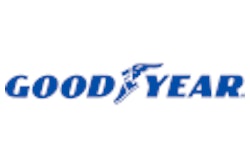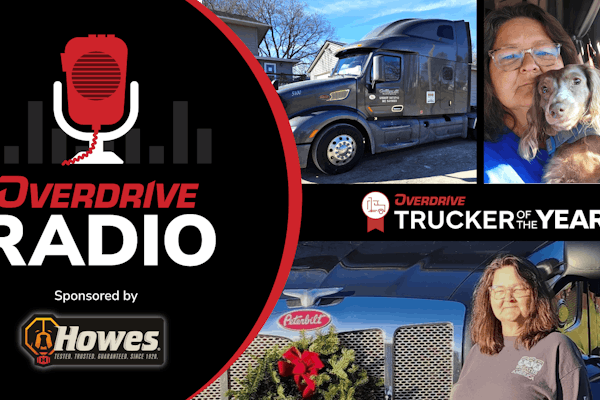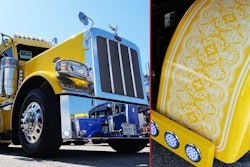The tread pattern of the Continental HDL Eco Plus TR shows tread blocks, a closed shoulder and fine siping.
Tire tread looks simpler than it is. Different tread patterns grip the road in different ways and directions, depending on the wheel position and road conditions. Roger Stansbie, director of radial tire technology at the Continental Commercial Division says the basic goal of tread is contact with the road’s surface. “The goal is to get the rubber to break through the snow or water film and get in contact with the road surface and bite into it,” he says.
The tread does this by allowing a place for the excess water to go, says Tim Miller, Goodyear marketing communications director for commercial tires. “Tread patterns provide traction for any condition other than dry, hard surfaces,” he says. Elements of the tread squeegee water, mud or slush into a tire’s grooves for enhanced wet traction. “The sharp edges of the individual tread element give the tire added bite,” Miller says.
Picking the right tread for your operation can save fuel, minimize irregular wear, maximize retreadability and optimize the balance between fuel economy and tire life.
Different tread types
All truck tires are designed specifically for applications and positions, says Guy Walenga, director of engineering for commercial products at Bridgestone Bandag Tire Solutions. Aggressive lug-type treads, like those used on most drive tires, are better for snow and mud. Rib-type tires offer lateral stability, helping both tractor and trailer to corner better. But tread type isn’t exclusively dependent on wheel position.
“Steer and trailer tires are typically made with shallower tread depths because wear patterns tend to occur when the original tread depth is too deep,” Miller says. “In many cases, a rib-type tire would provide acceptable traction on a drive axle, except when gripping traction is needed.”
For cornering, Stansbie says drivers “need to actually drag the vehicle around the corner.” That means the tractor doesn’t just follow where the tire is headed. The tire has to turn sharper than the curve the vehicle follows. So, he says, “ribs are used because they generate higher cornering forces.”
Steer tires “have circumferential grooves because they don’t have to deal with torque and exhaust braking forces,” Walenga says. “But steer tires can scuff with the outside tire, taking a different arc from the inside tire. Trailer tires have deep, straight circumferential grooves because wear is much lower. One way to combat irregular wear on steers is to use a shallower tread depth.”
The most technologically developed tires, Walenga says, are drive tires. “They may have lugs and either a closed or open shoulder. There is more of a void between the lugs in off-road drive tires – it’s a more aggressive design.” Drives can have a broken pattern as with lugs, or they can have ribs. One reason the lug is there is to pile on rubber. Tires with deeper tread – more rubber – will take longer to wear down to the point where the tread is no longer legal.
“Deeper lugs increasingly absorb energy,” Stansbie says. “They generate more heat, which always comes, in the end, from the fuel tank. So cooler tires are better for fuel economy. It’s a similar principle to running a tire properly inflated versus running it under-inflated.”
When the tire rolls, the rubber is compressed as it goes underneath and becomes part of the tire’s “contact patch” with the road surface and supports the chassis. Hysteresis refers to the fact that the rubber never quite springs back all the way, and it’s this failure to spring back that leads to rolling resistance – fuel-robbing friction between the tire and the road. The deeper the tread, the more hysteresis it generates. Walenga says one reason for the block or “lug” tread design is that it allows more cooling air in to remove the heat generated by hysteresis.
As a result, he reports, drive tires may be 25/32, 28/32 or even 32/32 in. deep to help them last longer. Steers are normally 16/32, 18/32 or at most 19/32 in. deep. Trailer tires are typically 14/32.
Tread and the cost of operation
Climate and topography help determine tread design.
“A fleet operating in a desert environment may run rib tires in all wheel positions,” Miller says. “But most fleets don’t operate in such limited geography. More aggressive drive tires are required by any vehicle that might confront winter or challenging road conditions.”
Don Baldwin, business segment manager for Michelin Tires North America, says, “There is no rule of thumb by latitude – the weather can be very different even at the same distance from the equator. You need to ask yourself, ‘What are the predominant conditions?'”
Baldwin recommends you search for “fuel-efficient tires that also give good traction. There is less and less specialization of tire design for winter.” As tire design improves, standard tires give better and better traction. Baldwin knows of one fleet that runs trailer tires in the drive position to save fuel. He says, “Most fleets don’t have as much of a problem with traction as they did in the past. You’ll encounter many fleets running smaller lug-drive tires. One fleet in Bangor, Maine, runs fuel-efficient X One wide-base singles, and not snows, and they had good results last winter.”
“How many times, on paved roads, do you really need snow tires?” Walenga says. “Roads are typically cleaned off, even in Minnesota. And, if in deep snow in the middle of a snowstorm or in a mountain pass, you need to chain up, anyway, just to run legally.” Walenga states an opinion most echo: “You don’t generally need lugs on your drive tires for highway operation, even though most drivers like them.”
Beyond tread type is the choice between fuel-economy-boosting tires and tires that give maximum life or come at a lower initial cost. “Low-rolling-resistance tread compounds have low hysteresis, while earlier formulations have high hysteresis and do not return the energy when they leave the contact patch to help roll the vehicle forward,” Stansbie says. “When it comes to saving fuel, you can do more with tread compounding than you can with tread design.” Walenga estimates 60 percent of the improvement comes from the compound.
The more efficient tread compounds use more natural rubber, which has lower hysteresis. “Unfortunately,” Stansbie says, “the price of natural rubber is through the roof!”
The sources agreed that the less-efficient, high-hysteresis compounds tend to resist irregular wear because they move around and scrub off the distorted areas. So, Walenga says, the best fuel-efficient tires may actually incorporate two different layers – two different compounds – in the tread, the deeper compound minimizing hysteresis and the top layer resisting irregular wear.
Also, much of the magic is in the tread design. One example is “interlocking sipes.” “They reduce the movement in the footprint,” Stansbie says, thus allowing an improvement in both wear and fuel efficiency. These tiny cuts allow the tread sections to be held tightly together by their structure so they move less (meaning less hysteresis) yet provide the sharp edges and water-carrying channels needed for traction.
Baldwin says matrix siping works the same way. These are sipes that zig-zag, as seen both from the top and the side. A tread section “acts like a block,” he says, “but provides grip with the sipes. Fuel-efficient tires have more and more siping, which allows both fuel economy and traction.”
Still, Walenga says, “long-mileage tires tend to give poorer fuel economy, and fuel-economy tires don’t last as long.” This is mainly because you can’t build a fuel-efficient tire with a deep tread.
So what’s a trucker to do? First, add up the numbers. Fuel costs more than tires.
“The tradeoff between less tread depth, which shortens life, and fuel efficiency, cost-wise, is 15:1,” Baldwin says. “So buy tires, not fuel!”
There are subtleties when it comes to the latest tires, too, so shop for them, preferably at a good dealer with good advice, Walenga suggests.
Finally, Walenga says, “Retreading is the smartest way to stay in business.” He and Stansbie point out that the reduction in energy usage that shows up as less heat in the fuel-efficient tire means “a better chance of re-using the casing,” Walenga says. “Heat history is additive.” Lower temperatures mean more hours on the road for a tire casing. Using retreading, including the recycling of his own casings, a trucker can replace tires more frequently without adding cost.
Walenga says a fuel-efficient tread can be applied in the retreading process, too, meaning the fuel savings will continue. So, buy tires and retreads, not fuel.
For more information:
Goodyear Tire and Rubber Co.
330 796-2121
www.goodyear.com
Bridgestone Bandag Tire Solutions
800 543-7522
www.bridgestone-firestone.com
Michelin Tires North America
866 866-6605
www.michelin-us.com
Continental
704 583-8737
www.conti-online.com







